Mechanical Failure Case study 2022
VerifiedAdded on 2022/09/30
|10
|2193
|31
AI Summary
Contribute Materials
Your contribution can guide someone’s learning journey. Share your
documents today.
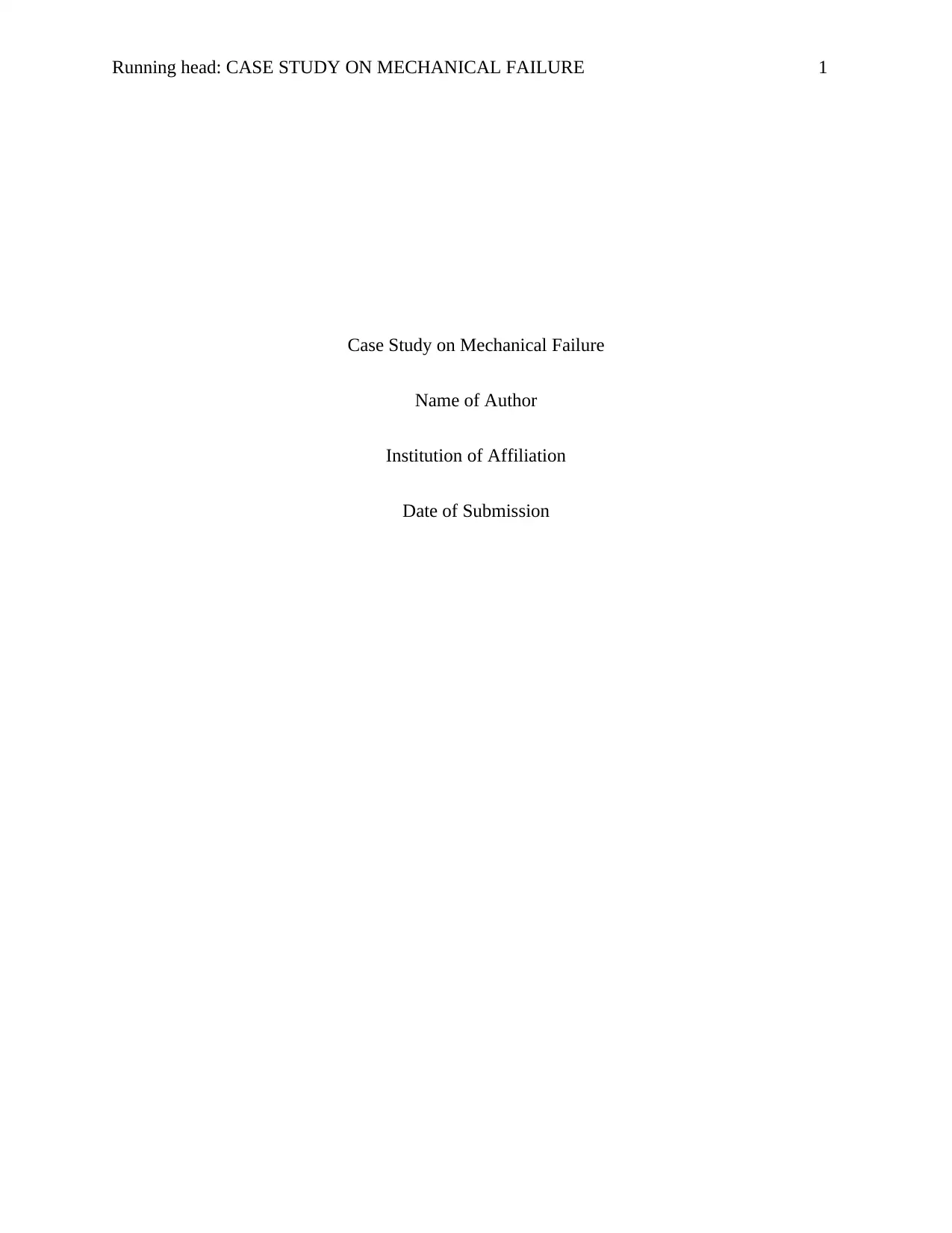
Running head: CASE STUDY ON MECHANICAL FAILURE 1
Case Study on Mechanical Failure
Name of Author
Institution of Affiliation
Date of Submission
Case Study on Mechanical Failure
Name of Author
Institution of Affiliation
Date of Submission
Secure Best Marks with AI Grader
Need help grading? Try our AI Grader for instant feedback on your assignments.
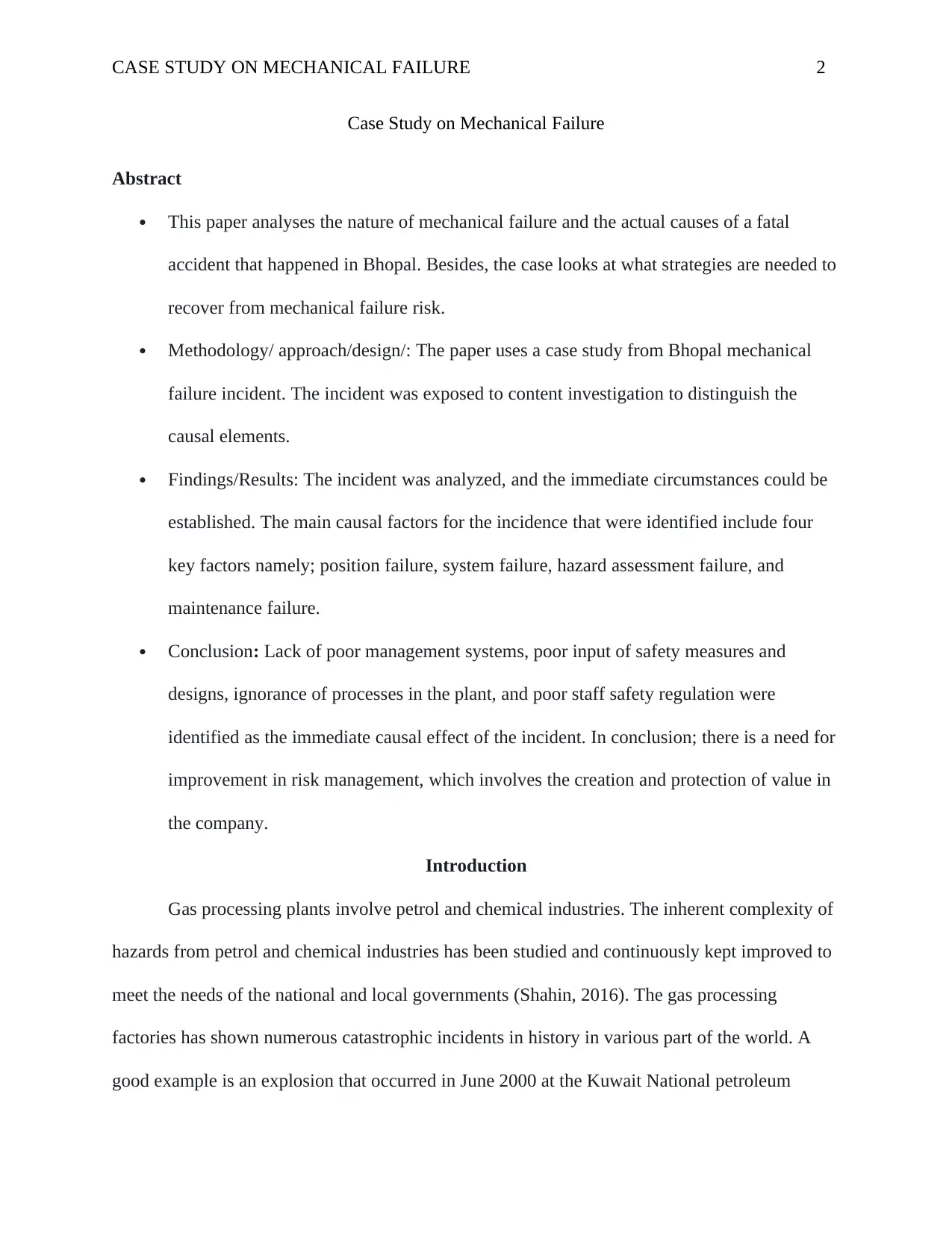
CASE STUDY ON MECHANICAL FAILURE 2
Case Study on Mechanical Failure
Abstract
This paper analyses the nature of mechanical failure and the actual causes of a fatal
accident that happened in Bhopal. Besides, the case looks at what strategies are needed to
recover from mechanical failure risk.
Methodology/ approach/design/: The paper uses a case study from Bhopal mechanical
failure incident. The incident was exposed to content investigation to distinguish the
causal elements.
Findings/Results: The incident was analyzed, and the immediate circumstances could be
established. The main causal factors for the incidence that were identified include four
key factors namely; position failure, system failure, hazard assessment failure, and
maintenance failure.
Conclusion: Lack of poor management systems, poor input of safety measures and
designs, ignorance of processes in the plant, and poor staff safety regulation were
identified as the immediate causal effect of the incident. In conclusion; there is a need for
improvement in risk management, which involves the creation and protection of value in
the company.
Introduction
Gas processing plants involve petrol and chemical industries. The inherent complexity of
hazards from petrol and chemical industries has been studied and continuously kept improved to
meet the needs of the national and local governments (Shahin, 2016). The gas processing
factories has shown numerous catastrophic incidents in history in various part of the world. A
good example is an explosion that occurred in June 2000 at the Kuwait National petroleum
Case Study on Mechanical Failure
Abstract
This paper analyses the nature of mechanical failure and the actual causes of a fatal
accident that happened in Bhopal. Besides, the case looks at what strategies are needed to
recover from mechanical failure risk.
Methodology/ approach/design/: The paper uses a case study from Bhopal mechanical
failure incident. The incident was exposed to content investigation to distinguish the
causal elements.
Findings/Results: The incident was analyzed, and the immediate circumstances could be
established. The main causal factors for the incidence that were identified include four
key factors namely; position failure, system failure, hazard assessment failure, and
maintenance failure.
Conclusion: Lack of poor management systems, poor input of safety measures and
designs, ignorance of processes in the plant, and poor staff safety regulation were
identified as the immediate causal effect of the incident. In conclusion; there is a need for
improvement in risk management, which involves the creation and protection of value in
the company.
Introduction
Gas processing plants involve petrol and chemical industries. The inherent complexity of
hazards from petrol and chemical industries has been studied and continuously kept improved to
meet the needs of the national and local governments (Shahin, 2016). The gas processing
factories has shown numerous catastrophic incidents in history in various part of the world. A
good example is an explosion that occurred in June 2000 at the Kuwait National petroleum
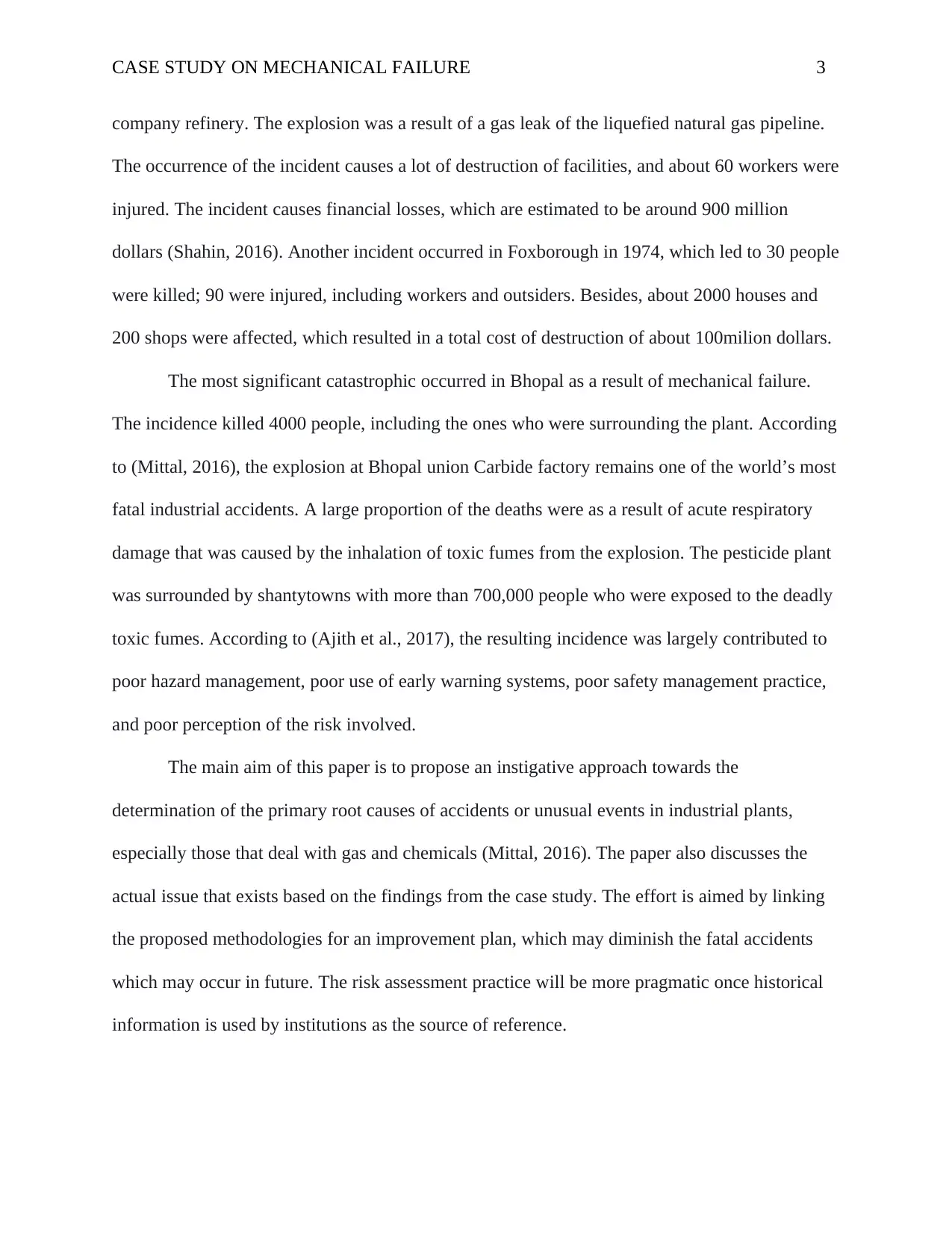
CASE STUDY ON MECHANICAL FAILURE 3
company refinery. The explosion was a result of a gas leak of the liquefied natural gas pipeline.
The occurrence of the incident causes a lot of destruction of facilities, and about 60 workers were
injured. The incident causes financial losses, which are estimated to be around 900 million
dollars (Shahin, 2016). Another incident occurred in Foxborough in 1974, which led to 30 people
were killed; 90 were injured, including workers and outsiders. Besides, about 2000 houses and
200 shops were affected, which resulted in a total cost of destruction of about 100milion dollars.
The most significant catastrophic occurred in Bhopal as a result of mechanical failure.
The incidence killed 4000 people, including the ones who were surrounding the plant. According
to (Mittal, 2016), the explosion at Bhopal union Carbide factory remains one of the world’s most
fatal industrial accidents. A large proportion of the deaths were as a result of acute respiratory
damage that was caused by the inhalation of toxic fumes from the explosion. The pesticide plant
was surrounded by shantytowns with more than 700,000 people who were exposed to the deadly
toxic fumes. According to (Ajith et al., 2017), the resulting incidence was largely contributed to
poor hazard management, poor use of early warning systems, poor safety management practice,
and poor perception of the risk involved.
The main aim of this paper is to propose an instigative approach towards the
determination of the primary root causes of accidents or unusual events in industrial plants,
especially those that deal with gas and chemicals (Mittal, 2016). The paper also discusses the
actual issue that exists based on the findings from the case study. The effort is aimed by linking
the proposed methodologies for an improvement plan, which may diminish the fatal accidents
which may occur in future. The risk assessment practice will be more pragmatic once historical
information is used by institutions as the source of reference.
company refinery. The explosion was a result of a gas leak of the liquefied natural gas pipeline.
The occurrence of the incident causes a lot of destruction of facilities, and about 60 workers were
injured. The incident causes financial losses, which are estimated to be around 900 million
dollars (Shahin, 2016). Another incident occurred in Foxborough in 1974, which led to 30 people
were killed; 90 were injured, including workers and outsiders. Besides, about 2000 houses and
200 shops were affected, which resulted in a total cost of destruction of about 100milion dollars.
The most significant catastrophic occurred in Bhopal as a result of mechanical failure.
The incidence killed 4000 people, including the ones who were surrounding the plant. According
to (Mittal, 2016), the explosion at Bhopal union Carbide factory remains one of the world’s most
fatal industrial accidents. A large proportion of the deaths were as a result of acute respiratory
damage that was caused by the inhalation of toxic fumes from the explosion. The pesticide plant
was surrounded by shantytowns with more than 700,000 people who were exposed to the deadly
toxic fumes. According to (Ajith et al., 2017), the resulting incidence was largely contributed to
poor hazard management, poor use of early warning systems, poor safety management practice,
and poor perception of the risk involved.
The main aim of this paper is to propose an instigative approach towards the
determination of the primary root causes of accidents or unusual events in industrial plants,
especially those that deal with gas and chemicals (Mittal, 2016). The paper also discusses the
actual issue that exists based on the findings from the case study. The effort is aimed by linking
the proposed methodologies for an improvement plan, which may diminish the fatal accidents
which may occur in future. The risk assessment practice will be more pragmatic once historical
information is used by institutions as the source of reference.
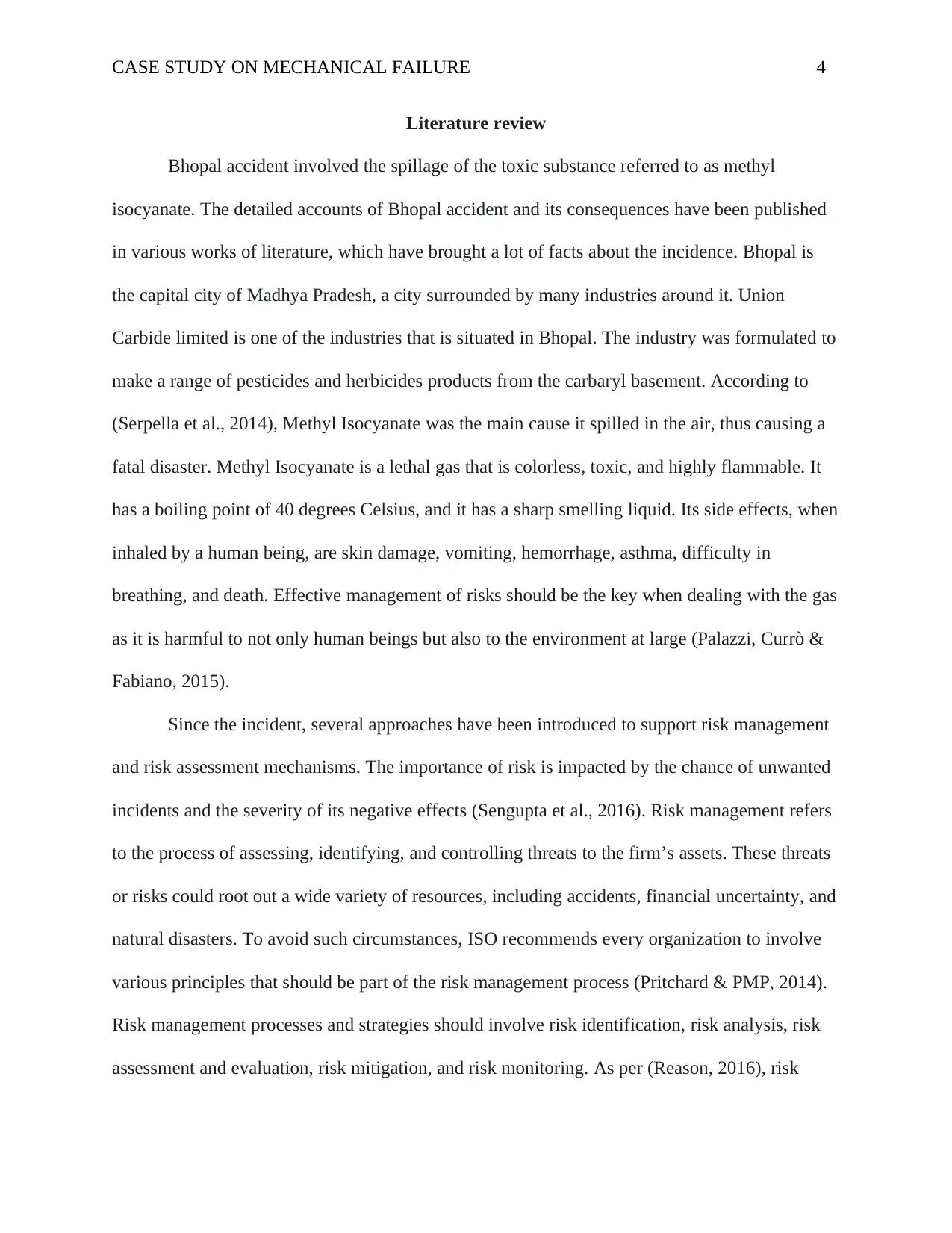
CASE STUDY ON MECHANICAL FAILURE 4
Literature review
Bhopal accident involved the spillage of the toxic substance referred to as methyl
isocyanate. The detailed accounts of Bhopal accident and its consequences have been published
in various works of literature, which have brought a lot of facts about the incidence. Bhopal is
the capital city of Madhya Pradesh, a city surrounded by many industries around it. Union
Carbide limited is one of the industries that is situated in Bhopal. The industry was formulated to
make a range of pesticides and herbicides products from the carbaryl basement. According to
(Serpella et al., 2014), Methyl Isocyanate was the main cause it spilled in the air, thus causing a
fatal disaster. Methyl Isocyanate is a lethal gas that is colorless, toxic, and highly flammable. It
has a boiling point of 40 degrees Celsius, and it has a sharp smelling liquid. Its side effects, when
inhaled by a human being, are skin damage, vomiting, hemorrhage, asthma, difficulty in
breathing, and death. Effective management of risks should be the key when dealing with the gas
as it is harmful to not only human beings but also to the environment at large (Palazzi, Currò &
Fabiano, 2015).
Since the incident, several approaches have been introduced to support risk management
and risk assessment mechanisms. The importance of risk is impacted by the chance of unwanted
incidents and the severity of its negative effects (Sengupta et al., 2016). Risk management refers
to the process of assessing, identifying, and controlling threats to the firm’s assets. These threats
or risks could root out a wide variety of resources, including accidents, financial uncertainty, and
natural disasters. To avoid such circumstances, ISO recommends every organization to involve
various principles that should be part of the risk management process (Pritchard & PMP, 2014).
Risk management processes and strategies should involve risk identification, risk analysis, risk
assessment and evaluation, risk mitigation, and risk monitoring. As per (Reason, 2016), risk
Literature review
Bhopal accident involved the spillage of the toxic substance referred to as methyl
isocyanate. The detailed accounts of Bhopal accident and its consequences have been published
in various works of literature, which have brought a lot of facts about the incidence. Bhopal is
the capital city of Madhya Pradesh, a city surrounded by many industries around it. Union
Carbide limited is one of the industries that is situated in Bhopal. The industry was formulated to
make a range of pesticides and herbicides products from the carbaryl basement. According to
(Serpella et al., 2014), Methyl Isocyanate was the main cause it spilled in the air, thus causing a
fatal disaster. Methyl Isocyanate is a lethal gas that is colorless, toxic, and highly flammable. It
has a boiling point of 40 degrees Celsius, and it has a sharp smelling liquid. Its side effects, when
inhaled by a human being, are skin damage, vomiting, hemorrhage, asthma, difficulty in
breathing, and death. Effective management of risks should be the key when dealing with the gas
as it is harmful to not only human beings but also to the environment at large (Palazzi, Currò &
Fabiano, 2015).
Since the incident, several approaches have been introduced to support risk management
and risk assessment mechanisms. The importance of risk is impacted by the chance of unwanted
incidents and the severity of its negative effects (Sengupta et al., 2016). Risk management refers
to the process of assessing, identifying, and controlling threats to the firm’s assets. These threats
or risks could root out a wide variety of resources, including accidents, financial uncertainty, and
natural disasters. To avoid such circumstances, ISO recommends every organization to involve
various principles that should be part of the risk management process (Pritchard & PMP, 2014).
Risk management processes and strategies should involve risk identification, risk analysis, risk
assessment and evaluation, risk mitigation, and risk monitoring. As per (Reason, 2016), risk
Secure Best Marks with AI Grader
Need help grading? Try our AI Grader for instant feedback on your assignments.
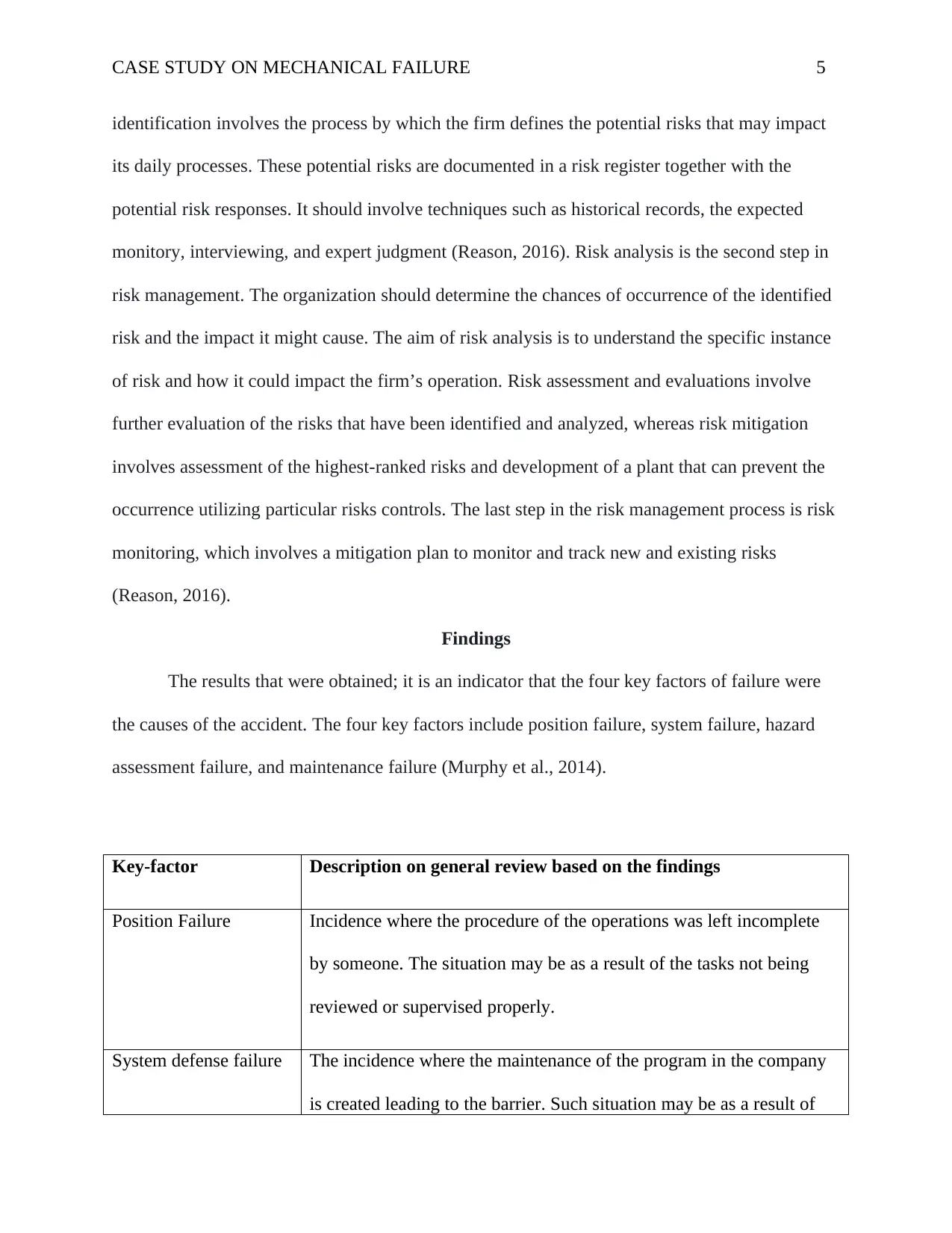
CASE STUDY ON MECHANICAL FAILURE 5
identification involves the process by which the firm defines the potential risks that may impact
its daily processes. These potential risks are documented in a risk register together with the
potential risk responses. It should involve techniques such as historical records, the expected
monitory, interviewing, and expert judgment (Reason, 2016). Risk analysis is the second step in
risk management. The organization should determine the chances of occurrence of the identified
risk and the impact it might cause. The aim of risk analysis is to understand the specific instance
of risk and how it could impact the firm’s operation. Risk assessment and evaluations involve
further evaluation of the risks that have been identified and analyzed, whereas risk mitigation
involves assessment of the highest-ranked risks and development of a plant that can prevent the
occurrence utilizing particular risks controls. The last step in the risk management process is risk
monitoring, which involves a mitigation plan to monitor and track new and existing risks
(Reason, 2016).
Findings
The results that were obtained; it is an indicator that the four key factors of failure were
the causes of the accident. The four key factors include position failure, system failure, hazard
assessment failure, and maintenance failure (Murphy et al., 2014).
Key-factor Description on general review based on the findings
Position Failure Incidence where the procedure of the operations was left incomplete
by someone. The situation may be as a result of the tasks not being
reviewed or supervised properly.
System defense failure The incidence where the maintenance of the program in the company
is created leading to the barrier. Such situation may be as a result of
identification involves the process by which the firm defines the potential risks that may impact
its daily processes. These potential risks are documented in a risk register together with the
potential risk responses. It should involve techniques such as historical records, the expected
monitory, interviewing, and expert judgment (Reason, 2016). Risk analysis is the second step in
risk management. The organization should determine the chances of occurrence of the identified
risk and the impact it might cause. The aim of risk analysis is to understand the specific instance
of risk and how it could impact the firm’s operation. Risk assessment and evaluations involve
further evaluation of the risks that have been identified and analyzed, whereas risk mitigation
involves assessment of the highest-ranked risks and development of a plant that can prevent the
occurrence utilizing particular risks controls. The last step in the risk management process is risk
monitoring, which involves a mitigation plan to monitor and track new and existing risks
(Reason, 2016).
Findings
The results that were obtained; it is an indicator that the four key factors of failure were
the causes of the accident. The four key factors include position failure, system failure, hazard
assessment failure, and maintenance failure (Murphy et al., 2014).
Key-factor Description on general review based on the findings
Position Failure Incidence where the procedure of the operations was left incomplete
by someone. The situation may be as a result of the tasks not being
reviewed or supervised properly.
System defense failure The incidence where the maintenance of the program in the company
is created leading to the barrier. Such situation may be as a result of
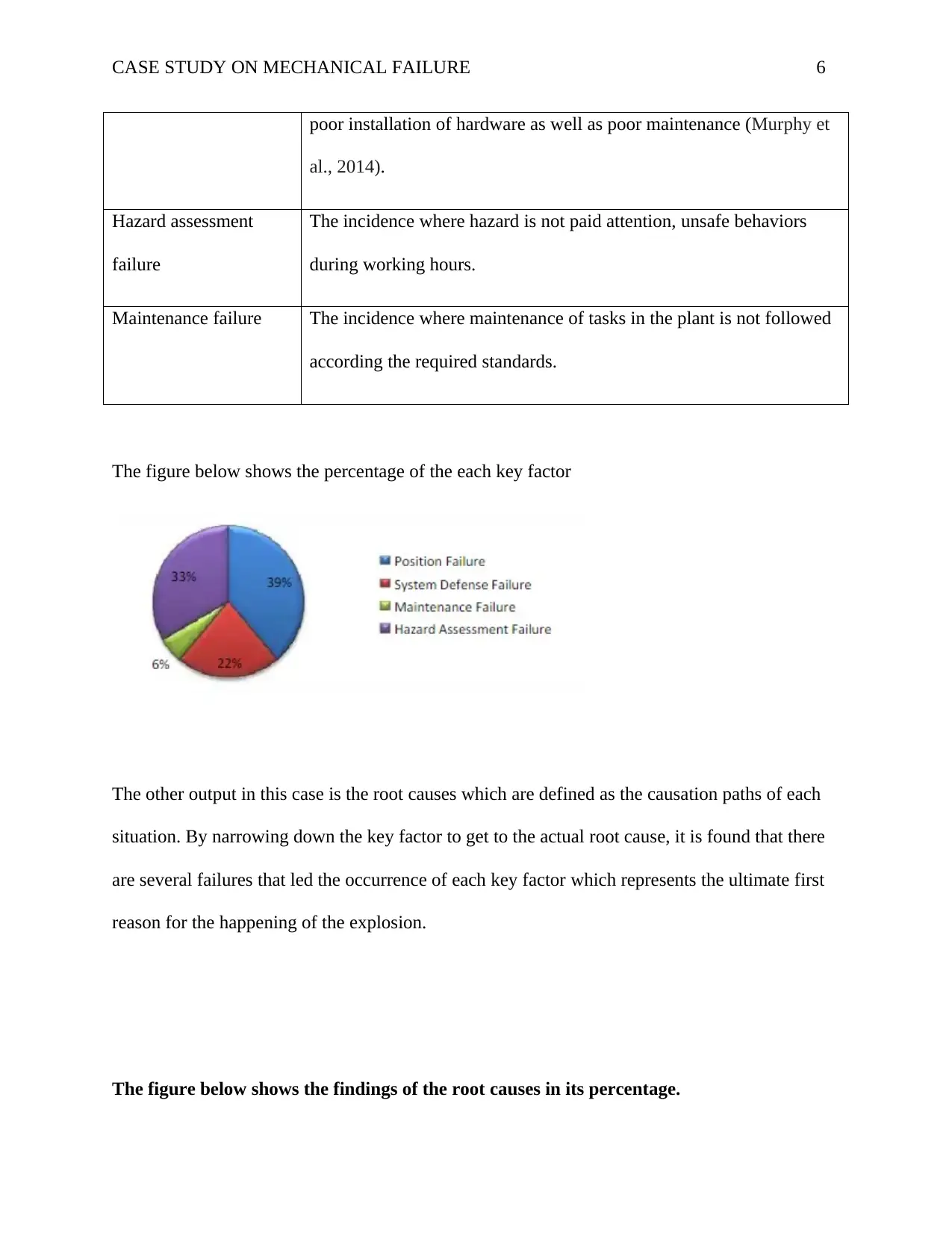
CASE STUDY ON MECHANICAL FAILURE 6
poor installation of hardware as well as poor maintenance (Murphy et
al., 2014).
Hazard assessment
failure
The incidence where hazard is not paid attention, unsafe behaviors
during working hours.
Maintenance failure The incidence where maintenance of tasks in the plant is not followed
according the required standards.
The figure below shows the percentage of the each key factor
The other output in this case is the root causes which are defined as the causation paths of each
situation. By narrowing down the key factor to get to the actual root cause, it is found that there
are several failures that led the occurrence of each key factor which represents the ultimate first
reason for the happening of the explosion.
The figure below shows the findings of the root causes in its percentage.
poor installation of hardware as well as poor maintenance (Murphy et
al., 2014).
Hazard assessment
failure
The incidence where hazard is not paid attention, unsafe behaviors
during working hours.
Maintenance failure The incidence where maintenance of tasks in the plant is not followed
according the required standards.
The figure below shows the percentage of the each key factor
The other output in this case is the root causes which are defined as the causation paths of each
situation. By narrowing down the key factor to get to the actual root cause, it is found that there
are several failures that led the occurrence of each key factor which represents the ultimate first
reason for the happening of the explosion.
The figure below shows the findings of the root causes in its percentage.
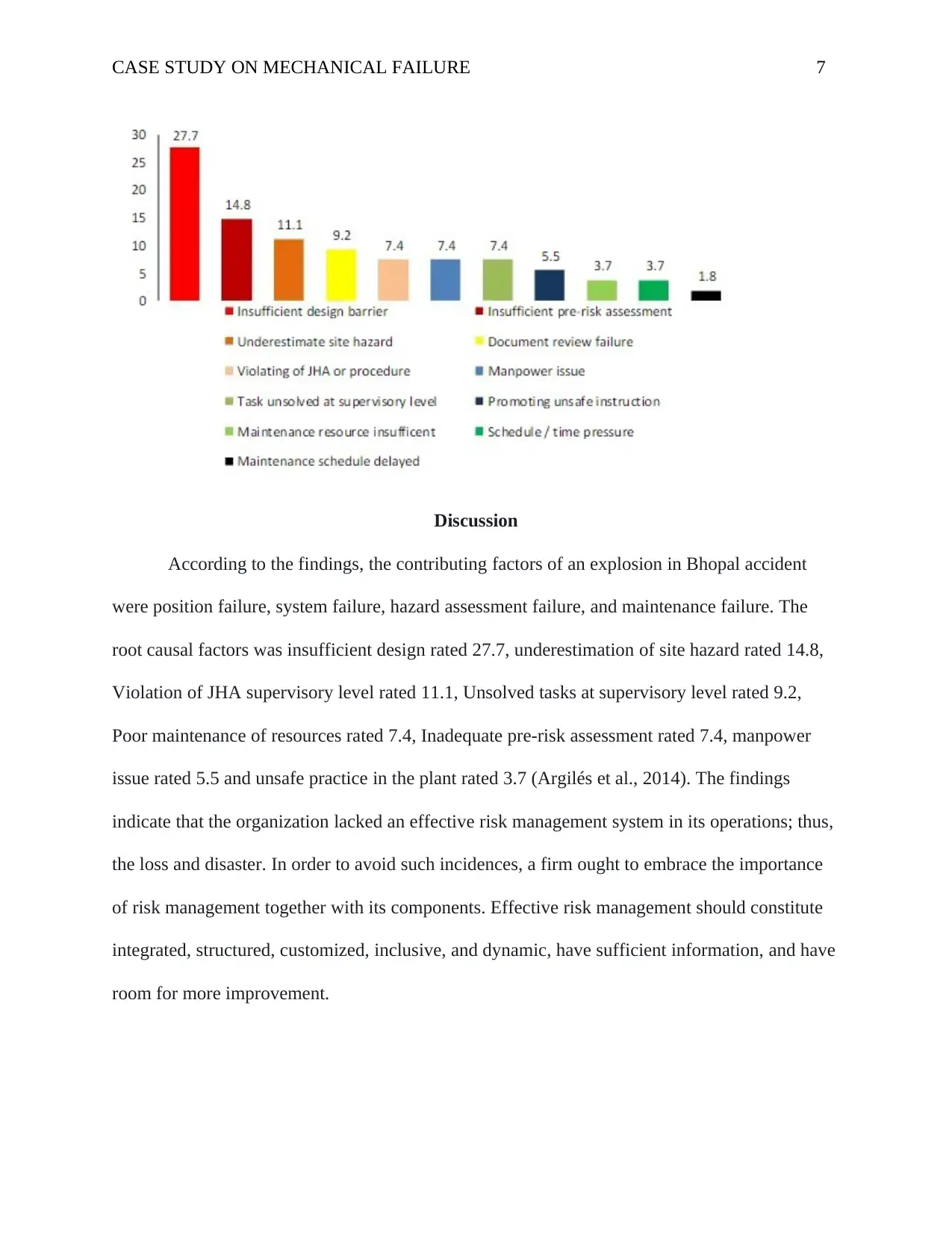
CASE STUDY ON MECHANICAL FAILURE 7
Discussion
According to the findings, the contributing factors of an explosion in Bhopal accident
were position failure, system failure, hazard assessment failure, and maintenance failure. The
root causal factors was insufficient design rated 27.7, underestimation of site hazard rated 14.8,
Violation of JHA supervisory level rated 11.1, Unsolved tasks at supervisory level rated 9.2,
Poor maintenance of resources rated 7.4, Inadequate pre-risk assessment rated 7.4, manpower
issue rated 5.5 and unsafe practice in the plant rated 3.7 (Argilés et al., 2014). The findings
indicate that the organization lacked an effective risk management system in its operations; thus,
the loss and disaster. In order to avoid such incidences, a firm ought to embrace the importance
of risk management together with its components. Effective risk management should constitute
integrated, structured, customized, inclusive, and dynamic, have sufficient information, and have
room for more improvement.
Discussion
According to the findings, the contributing factors of an explosion in Bhopal accident
were position failure, system failure, hazard assessment failure, and maintenance failure. The
root causal factors was insufficient design rated 27.7, underestimation of site hazard rated 14.8,
Violation of JHA supervisory level rated 11.1, Unsolved tasks at supervisory level rated 9.2,
Poor maintenance of resources rated 7.4, Inadequate pre-risk assessment rated 7.4, manpower
issue rated 5.5 and unsafe practice in the plant rated 3.7 (Argilés et al., 2014). The findings
indicate that the organization lacked an effective risk management system in its operations; thus,
the loss and disaster. In order to avoid such incidences, a firm ought to embrace the importance
of risk management together with its components. Effective risk management should constitute
integrated, structured, customized, inclusive, and dynamic, have sufficient information, and have
room for more improvement.
Paraphrase This Document
Need a fresh take? Get an instant paraphrase of this document with our AI Paraphraser
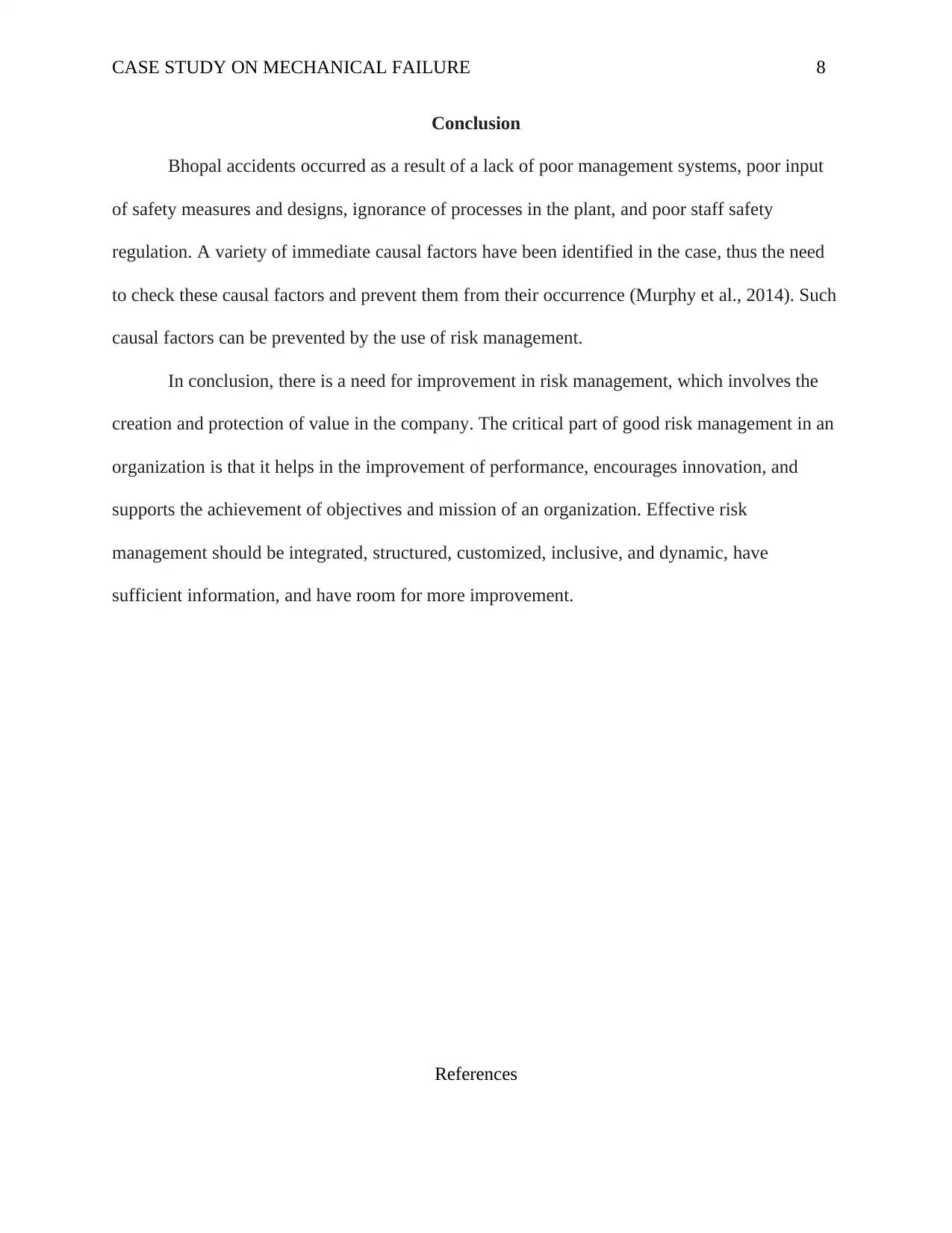
CASE STUDY ON MECHANICAL FAILURE 8
Conclusion
Bhopal accidents occurred as a result of a lack of poor management systems, poor input
of safety measures and designs, ignorance of processes in the plant, and poor staff safety
regulation. A variety of immediate causal factors have been identified in the case, thus the need
to check these causal factors and prevent them from their occurrence (Murphy et al., 2014). Such
causal factors can be prevented by the use of risk management.
In conclusion, there is a need for improvement in risk management, which involves the
creation and protection of value in the company. The critical part of good risk management in an
organization is that it helps in the improvement of performance, encourages innovation, and
supports the achievement of objectives and mission of an organization. Effective risk
management should be integrated, structured, customized, inclusive, and dynamic, have
sufficient information, and have room for more improvement.
References
Conclusion
Bhopal accidents occurred as a result of a lack of poor management systems, poor input
of safety measures and designs, ignorance of processes in the plant, and poor staff safety
regulation. A variety of immediate causal factors have been identified in the case, thus the need
to check these causal factors and prevent them from their occurrence (Murphy et al., 2014). Such
causal factors can be prevented by the use of risk management.
In conclusion, there is a need for improvement in risk management, which involves the
creation and protection of value in the company. The critical part of good risk management in an
organization is that it helps in the improvement of performance, encourages innovation, and
supports the achievement of objectives and mission of an organization. Effective risk
management should be integrated, structured, customized, inclusive, and dynamic, have
sufficient information, and have room for more improvement.
References
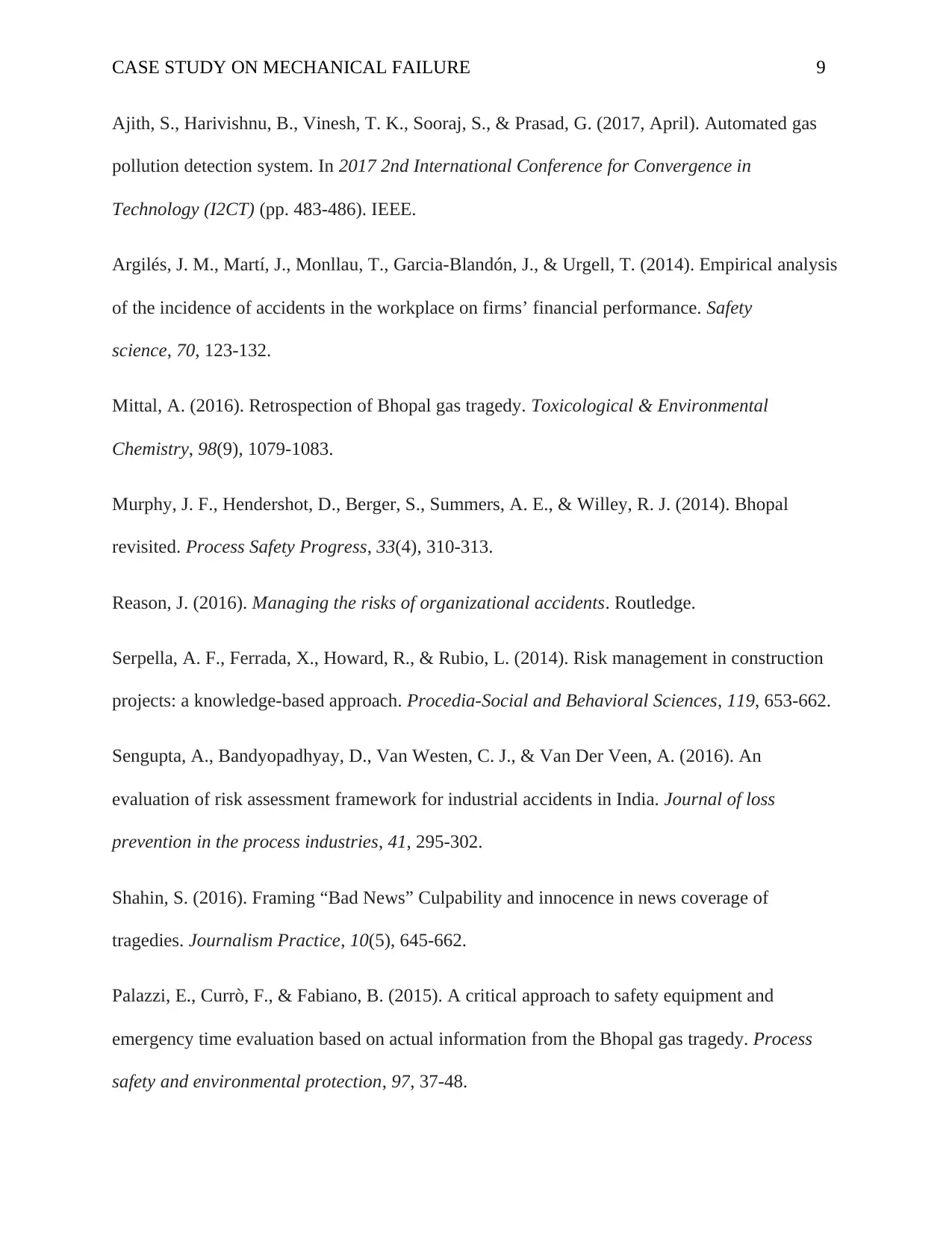
CASE STUDY ON MECHANICAL FAILURE 9
Ajith, S., Harivishnu, B., Vinesh, T. K., Sooraj, S., & Prasad, G. (2017, April). Automated gas
pollution detection system. In 2017 2nd International Conference for Convergence in
Technology (I2CT) (pp. 483-486). IEEE.
Argilés, J. M., Martí, J., Monllau, T., Garcia-Blandón, J., & Urgell, T. (2014). Empirical analysis
of the incidence of accidents in the workplace on firms’ financial performance. Safety
science, 70, 123-132.
Mittal, A. (2016). Retrospection of Bhopal gas tragedy. Toxicological & Environmental
Chemistry, 98(9), 1079-1083.
Murphy, J. F., Hendershot, D., Berger, S., Summers, A. E., & Willey, R. J. (2014). Bhopal
revisited. Process Safety Progress, 33(4), 310-313.
Reason, J. (2016). Managing the risks of organizational accidents. Routledge.
Serpella, A. F., Ferrada, X., Howard, R., & Rubio, L. (2014). Risk management in construction
projects: a knowledge-based approach. Procedia-Social and Behavioral Sciences, 119, 653-662.
Sengupta, A., Bandyopadhyay, D., Van Westen, C. J., & Van Der Veen, A. (2016). An
evaluation of risk assessment framework for industrial accidents in India. Journal of loss
prevention in the process industries, 41, 295-302.
Shahin, S. (2016). Framing “Bad News” Culpability and innocence in news coverage of
tragedies. Journalism Practice, 10(5), 645-662.
Palazzi, E., Currò, F., & Fabiano, B. (2015). A critical approach to safety equipment and
emergency time evaluation based on actual information from the Bhopal gas tragedy. Process
safety and environmental protection, 97, 37-48.
Ajith, S., Harivishnu, B., Vinesh, T. K., Sooraj, S., & Prasad, G. (2017, April). Automated gas
pollution detection system. In 2017 2nd International Conference for Convergence in
Technology (I2CT) (pp. 483-486). IEEE.
Argilés, J. M., Martí, J., Monllau, T., Garcia-Blandón, J., & Urgell, T. (2014). Empirical analysis
of the incidence of accidents in the workplace on firms’ financial performance. Safety
science, 70, 123-132.
Mittal, A. (2016). Retrospection of Bhopal gas tragedy. Toxicological & Environmental
Chemistry, 98(9), 1079-1083.
Murphy, J. F., Hendershot, D., Berger, S., Summers, A. E., & Willey, R. J. (2014). Bhopal
revisited. Process Safety Progress, 33(4), 310-313.
Reason, J. (2016). Managing the risks of organizational accidents. Routledge.
Serpella, A. F., Ferrada, X., Howard, R., & Rubio, L. (2014). Risk management in construction
projects: a knowledge-based approach. Procedia-Social and Behavioral Sciences, 119, 653-662.
Sengupta, A., Bandyopadhyay, D., Van Westen, C. J., & Van Der Veen, A. (2016). An
evaluation of risk assessment framework for industrial accidents in India. Journal of loss
prevention in the process industries, 41, 295-302.
Shahin, S. (2016). Framing “Bad News” Culpability and innocence in news coverage of
tragedies. Journalism Practice, 10(5), 645-662.
Palazzi, E., Currò, F., & Fabiano, B. (2015). A critical approach to safety equipment and
emergency time evaluation based on actual information from the Bhopal gas tragedy. Process
safety and environmental protection, 97, 37-48.
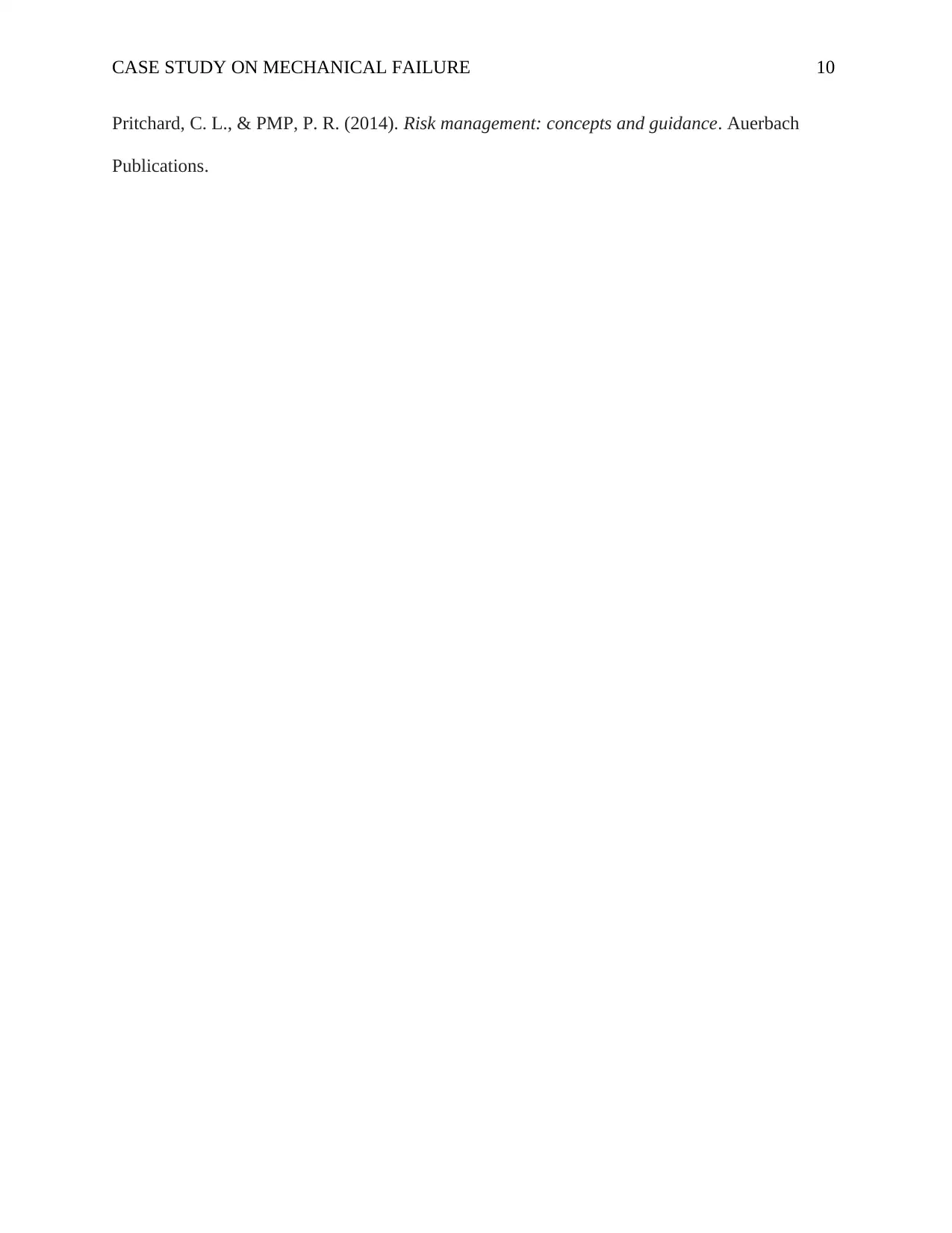
CASE STUDY ON MECHANICAL FAILURE 10
Pritchard, C. L., & PMP, P. R. (2014). Risk management: concepts and guidance. Auerbach
Publications.
Pritchard, C. L., & PMP, P. R. (2014). Risk management: concepts and guidance. Auerbach
Publications.
1 out of 10
Related Documents
Your All-in-One AI-Powered Toolkit for Academic Success.
+13062052269
info@desklib.com
Available 24*7 on WhatsApp / Email
![[object Object]](/_next/static/media/star-bottom.7253800d.svg)
Unlock your academic potential
© 2024 | Zucol Services PVT LTD | All rights reserved.





